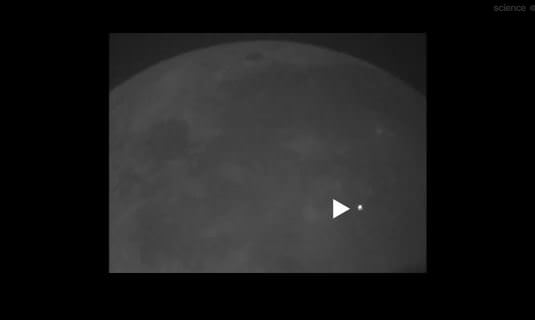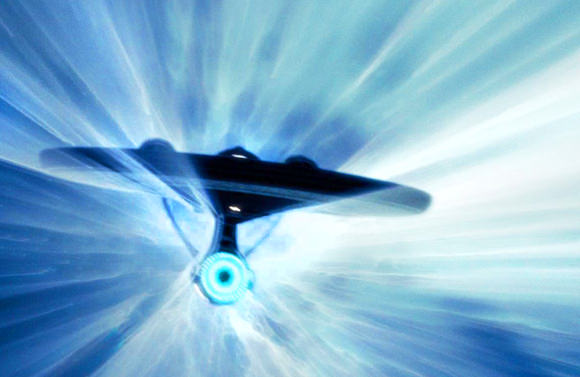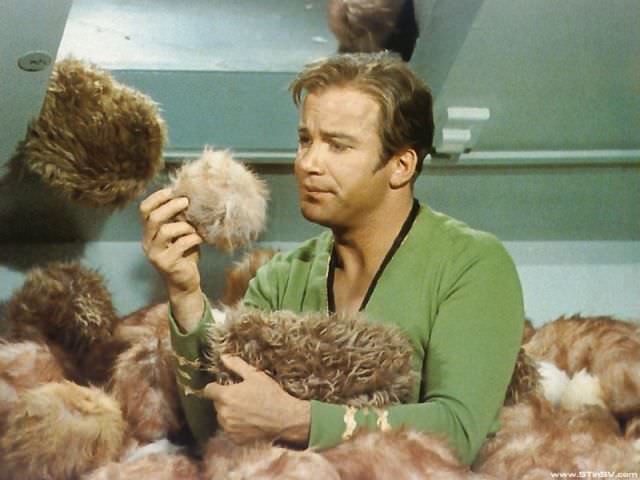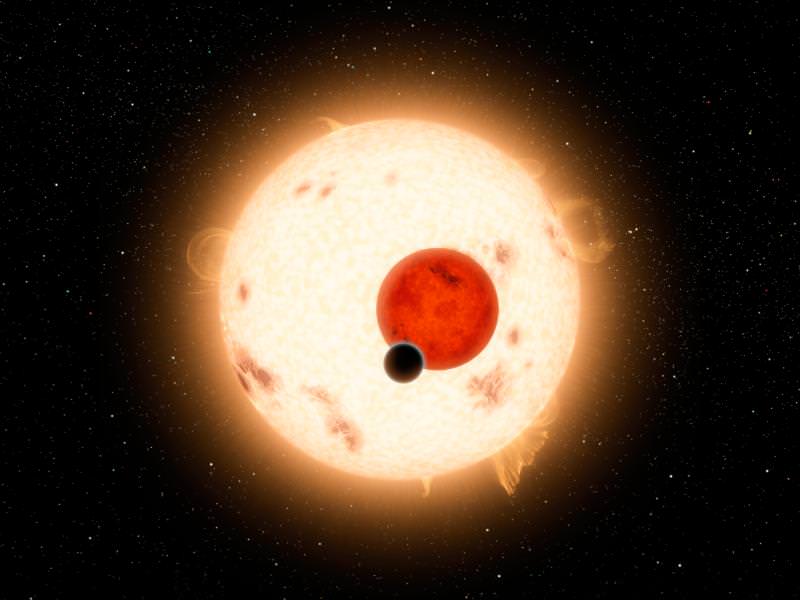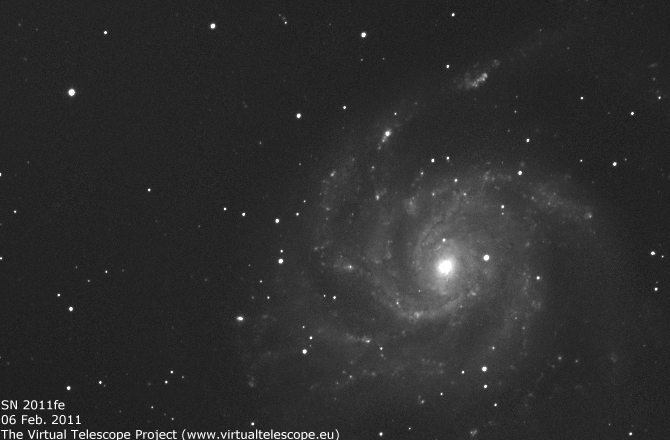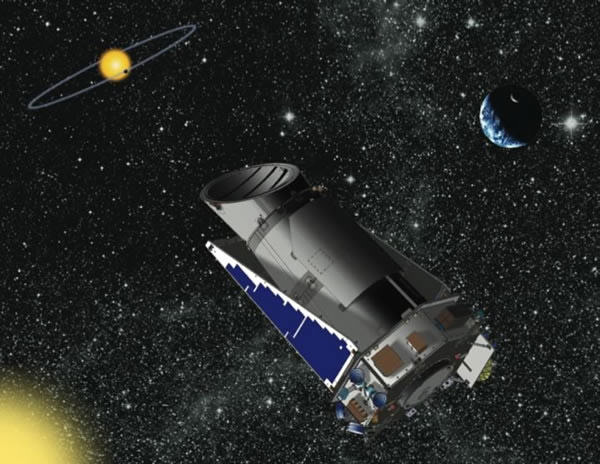Have you seen Star Trek: Into Darkness yet? If so, did you see the NASA-themed trailer, too? A crowd-funded 30-second video called “We Are the Explorers” is debuting at theaters this week, shown before the new Trek film begins. It highlights America’s future in space and is narrated by actor Peter Cullen, the voice of head Transformer Optimus Prime.
Continue reading “This is the new ‘We Are the Explorers’ Video You’ll See at ‘Star Trek: Into Darkness””
Super-Bright Explosion Seen on the Moon
If you were looking up at the Moon on March 17, 2013 at 03:50:55 UTC, you might have seen one of the brightest “lunar flashes” ever witnessed. And it would have been visible with just the naked eye.
“On March 17, 2013, an object about the size of a small boulder hit the lunar surface in Mare Imbrium,” says Bill Cooke of NASA’s Meteoroid Environment Office. “It exploded in a flash nearly 10 times as bright as anything we’ve ever seen before.”
The scientists estimate that the flash came from a 40 kg meteoroid measuring 0.3 to 0.4 meters wide hitting the Moon, likely traveling about 90,000 km/hr (56,000 mph.) The resulting explosion packed as much punch as 5 tons of TNT.
(FYI, lunar meteors hit the ground with so much kinetic energy that they don’t require an oxygen atmosphere to create a visible explosion. The flash of light comes not from combustion but rather from the thermal glow of molten rock and hot vapors at the impact site.)
The crater could be as wide as 20 meters. The scientists for the Lunar Reconnaissance Orbiter are hoping to image the impact site the next time the spacecraft passes over the area. It should be relatively easy to spot, and lunar scientists are always on the lookout for recent impacts. Additionally, comparing the size of the crater to the brightness of the flash would give researchers a valuable “ground truth” measurement to validate lunar impact models.
Were you observing the Moon that night? Universe Today’s David Dickinson pointed out to me that it is quite possible an amateur could have caught it; however no amateur images have surfaced yet. The Moon would’ve been a waxing crescent and visible to the Pacific region and US West Coast at the time. If you have archived images or video, it might be worth a look. And we’d love to hear from you if you happened to catch anything! NASA said the impact site would have glowed like a 4th magnitude star for about one second.

During the past 8 years, Cooke and a team of NASA astronomers have been monitoring the Moon for signs of explosions caused by meteoroids hitting the lunar surface.
Ron Suggs, an analyst at the Marshall Space Flight Center, was the first to notice the March 17th impact in a digital video recorded by one of the monitoring program’s 14-inch telescopes. “It jumped right out at me, it was so bright,” he said.
During the 8 years of observations, the team has found that the flashes on the Moon are more common than anyone expected, with hundreds of detectable impacts occurring every year.
Since the monitoring program began in 2005, NASA’s lunar impact team has detected more than 300 strikes, most orders of magnitude fainter than the March 17th event. Statistically speaking, more than half of all lunar meteors come from known meteoroid streams such as the Perseids and Leonids. The rest are sporadic meteors–random bits of comet and asteroid debris of unknown parentage.
Cooke believes the lunar impact might have been part of a much larger event.
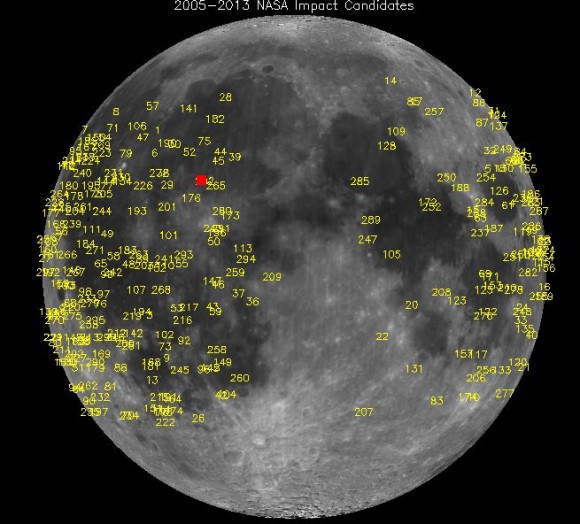
“On the night of March 17, NASA and University of Western Ontario all-sky cameras picked up an unusual number of deep-penetrating meteors right here on Earth,” he said. “These fireballs were traveling along nearly identical orbits between Earth and the asteroid belt.”
This means Earth and the Moon were pelted by meteoroids at about the same time.
“My working hypothesis is that the two events are related, and that this constitutes a short duration cluster of material encountered by the Earth-Moon system,” said Cooke.
One of the goals of the lunar monitoring program is to identify new streams of space debris that pose a potential threat to the Earth-Moon system. The March 17th event seems to be a good candidate.
Source: Science@NASA
Seeing the Red of ‘La Superba,’ a Magnificent Springtime Carbon Star
The Universe can be a very gray place. But this week, we’ll look at a fine example of a class of objects that defies this trend.
Many first time stargazers are surprised when the Trifid or the Orion Nebula fails to exhibit the bright splashy colors seen in Hubble photos. The fault lies not with the Universe, but in our very own eyes.
This is because the light sensitive fovea of our eye has two different types of photoreceptor cells; rods and cones. These act like slow and fast speed film (for those of us old enough to remember actual film!) Under low light conditions, objects have a very black-and-white appearance. It’s only with an increase in brightness that the color receptors in the cone cells of our eye begin to kick in.
One class of stars can induce this effect. They’re known as carbon stars.
A fine example of just such an object rides high in the late spring sky for northern hemisphere observers. This is the variable star Y Canum Venaticorum, also abbreviated as Y CVn or “La Superba” (The magnificent). This name was given to the star by Father Angelo Secchi in the mid-19th century. It is one of the reddest stars in the sky.
Astronomers gauge the “redness” of a star by measuring its magnitude contrast through a blue and visible (green peaking) filters. This is what is known as its B-V index, and the higher the value, the redder the star.
La Superba has a B-V value of +2.5. For contrast, the familiar orange-red stars Antares and Betelgeuse have a B-V value of +1.83 & +1.85, respectively.
Some other classic carbon stars and their B-V values are;
TX Piscium: +2.5
Herschel’s Garnet Star: +2.35
V Hydrae: +4.5
R Leporis (Hind’s Crimson Star): +2.7
Many of these are also variable stars, and they can appear redder visually near their minimum brightness. In the case of La Superba, it ranges from magnitude +4.8 to +6.3 over a span of 160 days, with a longer super-imposed cycle of about 6 years. We’re just coming off of a peak cycle in late May 2013, and La Superba is easy to spot with binoculars about a third of the way between the brilliant double star Cor Caroli (visited by the Enterprise in the Star Trek: The Next Generation Episode “Allegiance”) and Delta Ursa Majoris.
I’ve shown off carbon stars such as La Superba and Hind’s Crimson Star at public star parties to great effect. They can be an excellent star party “secret weapon” when every other ‘scope down the line is aimed at the Orion nebula.
For a faint constellation, Canes Venatici has lots to offer. One of the best globular clusters in the sky M3 can be found within its borders, as can a handful of decent galaxies. La Superba lies in a rather empty region of the constellation high above the galactic plane. In fact, an area about 15° degrees north of location in the adjoining constellation Ursa Major was picked for the famous Hubble Deep Field image for this very reason.
Burnham’s Celestial Handbook describes La Superba as “one of the reddest of all the naked eye stars, (with) a truly odd and vivid tint in large telescopes.” Astronomer Agnes Clerke described its appearance in 1905 as an “extraordinary vivacity of prismatic rays, separated into dazzling zones of red, yellow, and green by broad spaces of profound obscurity.” (Note: the “spaces” referred to gaps in its spectra).
Through the telescope at low power, we see La Superba as an orange-red ember with shades of white. It’s an easy catch with binoculars, and one of the very few carbon stars that is visible to the naked eye under dark skies. We’d judge that only TX Piscium rivals it in brightness, and only V Hydrae and Hinds appear ruddier. I always like to ask first time observers of colored stars what they see… human eye-brain perception can vary greatly!
The coordinates of La Superba are:
Right Ascension: 12 Hours 45’ 08”
Declination: +45 26’ 25”
La Superba is about 600-800 light years distant. Physically, it is a massive star at three times the mass of our Sun. It’s also a monster in terms of diameter, at four astronomical units in size. If you placed it within our solar system, it would swallow up the orbits of the interior planets out to Mars!
La Superba is thus much less dense than our own Sun, and at a surface temperature of about 2,800K, relatively cool. It is also the brightest “J-type” carbon star in the sky, a rare sub-type characterized by the presence of the isotope carbon-13 in its atmosphere. A carbon star is a sun near the end of its life, accumulating carbon compounds in its outer atmosphere as it fuses heavier elements in one last “hurrah” before shedding its outer layers and forming a white dwarf embedded inside a planetary nebula. Carbon stars are much brighter in the infrared, and we see the very tail end of this absorption in the visible red end of the spectrum. In fact, La Superba is a full 9 magnitudes (nearly 4,000 times) brighter in the near-infrared than in the ultraviolet!
All amazing facts to ponder as we view a star near the end of its career, seeding the cosmos with the very element that makes life possible. Next time you’re out observing, be sure to go “into the red” and check out the fine carbon star!
‘Star Trek’ Spaceship Model Soars Into Stratosphere
It was billed as the U.S. S. Enterprise’s first “real” flight in space, but the spaceship didn’t get quite that far.
A group of Star Trek fans launched a model of the famed fictional vessel to an altitude of 95,568 feet (29,129 meters) above Canada, or about 18.1 miles (29.1 kilometers), they told media.
The Karman line — a commonly accepted threshold for the edge of space — is at about 62 miles, or 100 kilometers, above sea level.
Still, the high-flying feat made the Canadian group quite happy, even though the ship made a suicidal crash landing at the end of its flight.
“We lost our engines,” said Steve Schnier, a member of the group that set Enterprise aloft with a weather balloon from Stayner, Ontario, in an interview with Canada AM.
“It wasn’t a smooth ride,” Schnier added concerning the ship’s final minutes. “It was moving, at one point, at 117 kilometres [72.7 miles] an hour.”
Enterprise smashed into the water near a Georgian Bay island in an area roughly 2.5 hours’ drive north of Canada’s largest city of Toronto. Searchers found it using a GPS signal.
The launch at the end of April came just weeks before Star Trek: Into Darkness, the next installment of the nearly 50-year-old franchise, zoomed into theaters in Canada and the United States this week. (Read our full review here.)
Weather balloon flights are used in science to collect information about the upper atmosphere. Other amateur groups have had fun using the idea, flying tokens ranging from teddy bears to Lego figurines.
How Many Tribbles Will Fit Into Your House?
Star Trek: How Many Tribbles Will Fit in Your House?
Oh, those little creatures that are no Tribble at all. If you’re not familiar with these small, non-intelligent lifeforms known for their prodigious reproductive rate, Tribbles (Polygeminus grex) are part of Star Trek lore. And we’ve all got Star Trek on the brain with the opening of the latest movie, Star Trek: Into Darkness (see our review here). So just for fun, here’s something that Nilz Baris would have loved to have access to. Provided by the folks at Movoto, this handy calculator will will tell you a.) not only how many Tribbles will fit into your home, but also, b.) how long it will take them to be fruitful and multiply to fill your home.
And for more fun here’s some estimates of how many Tribbles will fit into various landmarks, both real and imagined:
Empire State Building
Tribbles: 71,153,846
Time: 96 hours
White House
Tribbles: 1,375,000
Time: 72 Hours
Burj Khalifa
Tribbles: 96,342,614
ime: 96 hours
Painted Lady
Tribbles: 57,692
Time: 60
Wayne Manor
Tribbles: 980,769
Time: 72 hours
Millennium Falcon
Tribbles: 1,173,493
Time: 72 hours
Blocking Light Sheds New Light on Exoplanet Atmospheres
Exoplanets are uncanny. Some seem to have walked directly out of the best science-fiction movies. For example, we’ve discovered a planet consisting purely of water (GJ 1214b) and one with two suns (Kepler 16b). Some planets nearly scrape their host stars once every orbit, while others exist in darkness without a host star at all. The field of exoplanet research is moving beyond detecting exoplanets to characterizing them – understanding which molecules are present and if they might possibly harbor life.
A key research element in characterizing these alien worlds is observing their atmospheres. But how exactly do astronomers do this? We can’t simply tug the planet toward us to get a closer look. It’s also incredibly difficult to directly image their atmospheres from afar. Why? Stars are incredibly bright in comparison to their puny, barely reflective, and nearby exoplanets. So a direct image of an exoplanet’s atmosphere seemed out of the question – until recently.
It may be tricky to directly image an exoplanet’s atmosphere, but astronomers always have quite a few tricks up their sleeves. The first one is in mounting an instrument called a coronagraph on your telescope. This instrument blocks out the star’s light, leaving an image of the exoplanet alone. Another trick, known as adaptive optics, is to send a laser beam through the atmosphere. The changes in the laser allow us to monitor changes in the atmosphere, providing corrections to clean and smooth the image.
HR 8799, a large star orbited by four known giant planets, is relatively nearby (remember that ‘nearby’ is an astronomers way of saying that it is still pretty far, or in this case 130 light years away). In 2008, three of the planets were directly imaged using the Gemini and Keck telescopes on Mauna Kea, Hawaii. In 2010, the fourth planet, which was closest to the star and therefore the most difficult to see was directly imaged by the Keck telescope.
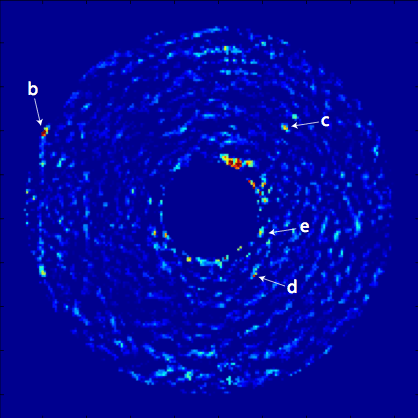
A direct image of an exoplanet’s atmosphere may tell us what color the atmosphere appears to be, and how thick the atmosphere is, but it gives us little more information. We need to know the atmospheric composition – the specific molecules and their abundances that are present within the atmosphere itself. If we’re looking at the question of habitability we need to know if there is water in the atmosphere or maybe carbon dioxide.
The key is in mounting a spectrograph on the telescope. Instead of collecting the overall light from the planet, that light is broken up into a spectrum of wavelengths. Imagine seeing a rainbow after a thunderstorm. That rainbow is simply the light from the sun broken up across all visible wavelengths due to ice crystals in our atmosphere. Molecules emit light at specific wavelengths, leaving well-known fingerprints that may be identified in a lab on Earth, in a rainbow in the sky, or in the spectrum of an exoplanet located 130 light years away.
When astronomers mounted their instrumentation (i.e. a coronagraph, an adaptive optics system, and a spectrograph) known as Project 1640 onboard the Palomar 5m Hale Telescope, they were able to shed new light on the HR 7899 system. Only last month one of its exoplanets revealed a mixture of water vapor and carbon monoxide in its atmosphere, but the story has changed. See a previous article in Universe Today.
Project 1640 observed not one – but four atmospheres at once. Gautam Vasisht of JPL explains, “in just one hour, we were able to get precise composition information about four planets around one overwhelmingly bright star.” These four exoplanets are believed to be coeval, in that they formed from a protoplanetary disk at roughly the same time. They also have the same luminosity and temperature, leading to the assumption that they are roughly similar to each other. But results show that they all have radically different spectra, and therefore different chemical compositions!
More specifically, HR 8799 b and d contain carbon dioxide, b and c contain ammonia, d and e contain methane, and b, d, and e contain acetylene. Noticing a few trends? There really aren’t any! Not only are these planets different from each other, they are also different from any other known objects. Acetylene, for example, has never been convincingly identified in a sub-stellar object outside the solar system. While the varying spectra pose many questions, one thing is clear: the diversity of planets must be greater than previously thought!
This is only the first exoplanet system for which we’ve obtained direct spectra of all exoplanet atmospheres. Project 1640 will conduct a 3-year survey of 200 nearby stars. The hope is to find hot Jupiters located far from their host star. While this is what the current technique allows astronomers to detect, it will also teach astronomers how Earth-like planets form.
“The outer giant planets dictate the fate of rocky ones like Earth. Giant planets can migrate in toward a star, and in the process, tug the smaller, rocky planets around or even kick them out of the system. We’re looking at hot Jupiters before they migrate in, and hope to understand more about how and when they might influence the destiny of the rocky, inner planets,” explained Vasisht.
In an attempt to understand our own blue marble, astronomers point their telescopes at uncanny worlds light years away. Project 1640 will block the light of distant stars in order to shed light on distant worlds as well as our own.
Sources: Jet Propulsion Laboratory, and B. R. Oppenheimer et al. 2013 ApJ 768 24
Hadfield’s Return to Earth: ‘I’m Still Learning How To Walk Again’
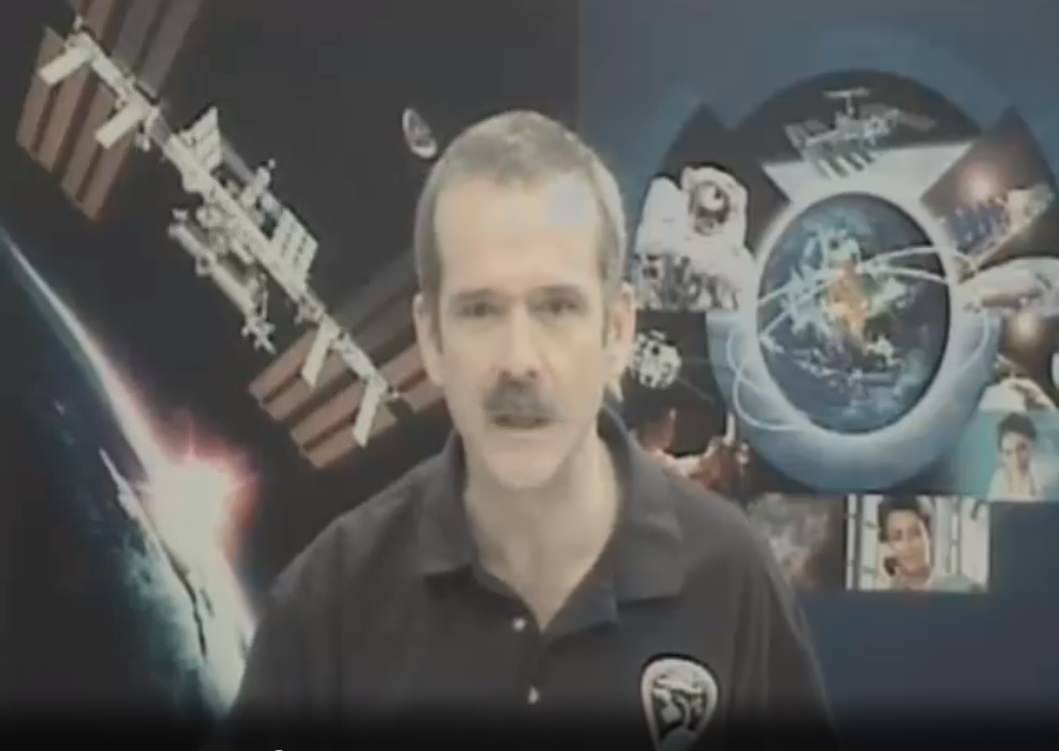
Astronaut Chris Hadfield described himself as a man who never looks back. Still, he spoke fondly of his five months in space during the first press conference with media today (May 16) after his return to Earth earlier this week.
“I don’t spend my life going gosh, I went to [space station] Mir in 1995 and now everything else is boring. That’s not how I ever felt,” the Canadian said in a wide-ranging conversation that talked about everything from his future, to the science he performed, his favorite tweets while up in space.
First, let’s get a big question off the plate. Hadfield says himself he doesn’t know what he wants to do next. “I’m still learning how to walk again!” he exclaimed to one journalist who asked if he wanted to be Canadian Space Agency president.
Rehabilitation is occupying a lot of his time, he added: “I’m trying to stand up straight, and I have to sit down in the shower so I don’t faint and fall down. It’s like asking an infant if they’re ready for their Ph.D. yet. I’ll get there, but it’s too early to say.”
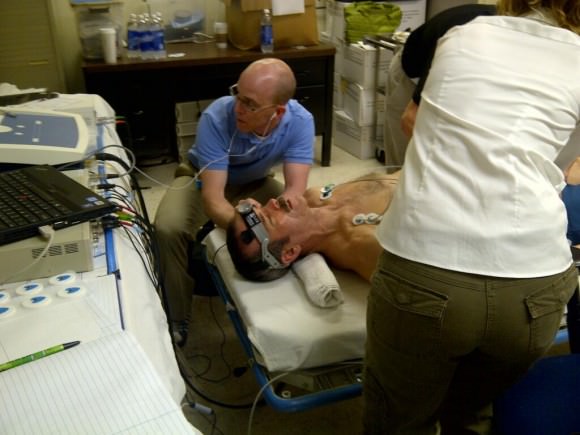
Hadfield brushed aside notions that he is famous for himself, saying it is a reflection of the hard work his crew put in on the station orbiting Earth. Expedition 35 was the most productive in terms of the science-to-maintenance ratio aboard the station, despite an ammonia leak gumming up the schedule very late in the mission.
He spoke most warmly of the science performed while aboard station. The Alpha Magnetic Spectrometer found possible hints of dark matter during his stay, for example. Hadfield and colleague Tom Marshburn also did aging research in space on behalf of the University of Waterloo, specifically looking at how blood pressure and blood flow changes among astronauts in orbit.
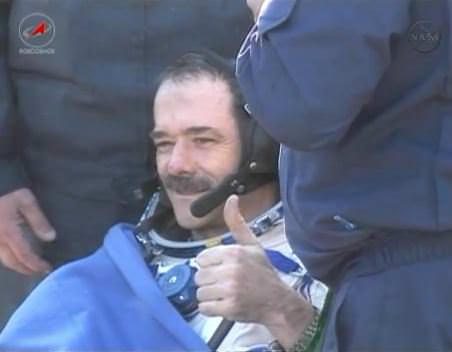
Education and outreach were also something Hadfield was proud of. “The purpose is to help people to understand what is possible on the space station, and the things we are doing,” he said of his prolific tweeting and video creation.
The results, in many cases, were incredible. More than 7,000 Canadian students took part in experiments linked to the International Space Station, he said. Thousands more took part in a nation-wide singalong starring Hadfield. (Watch it below.)
Once Hadfield gets his feet underneath him and the mission fades into the past, he said he’s hoping to resume his life normally.
Astronauts of yesteryear, he said, often had big missions thrust upon them early in their lives. At age 53, for example, Hadfield is roughly 15 years older than Neil Armstrong was during the first moon landing in 1969.
For Hadfield, with two decades under his belt as an astronaut — three missions, several backup crew assignments, and some management positions to boot — he treats his everyday life with the same enthusiasm as his high-flying job.
“I take just as much pride in the big dock that my neighbor Bob and I built at the cottage as I do in building Canadarm2 on the space station. Those were both very complex projects that required a lot of physical effort, planning, decision making, and the product is out there for everybody to see. I feel really good about them both.”
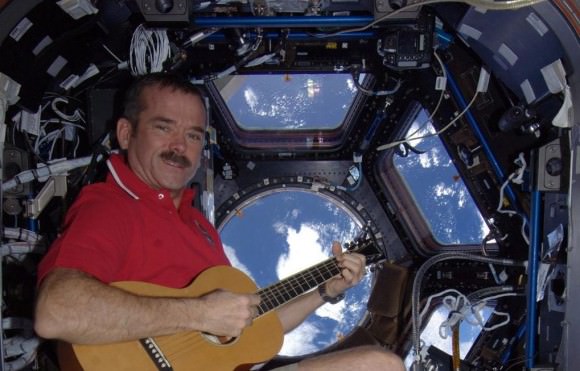
He acknowledged that in a budget-conscious environment, the Canadian Space Agency is facing uncertainty, but he added that to treat today’s uncertainty as something unique is the wrong thing. Every mission carries a real risk of death. Every budget vote can kill or revive a space program — the station itself was only funded by a vote in one crucial Congress session in its history, he added.
“To say that things are uncertain is to talk about the space business. We are always hostage to our next launch. There has never been a period of certainty in the space business, ever,” he said.
His advice to those wanting to follow in his footsteps?
“The key thing is within yourself. If you want to become something, you have to start turning yourself into that thing, step by step, as a demonstration of personal will. That’s what I did when I was nine. I started turning myself into an astronaut.”
Watch the entire video of his press conference here.
Live Online Event: The Exploding Universe: the Realm of Supernovae
Supernovae are some of the fascinating objects in the Universe. The Virtual Telescope Project will be hosting a live webcast today UPDATE: the webcast will also be on May 17, 2013 as clouds arrived shortly into the webcast on on the 16th) at 21:00 UTC (5 pm EDT, 2 pm PDT) to explore in real-time — from the comfort of your home or office –the exciting world of supernovae, those incredible, violent exploding stars. All this with the live commentary from a professional astrophysicist, Gianluca Masi.
You can watch at this link.
During “The Exploding Universe: the Realm of Supernovae”, you can join in and surf the Cosmos in space and time, observing dying stars placed millions of light years way and shining as billions of Sun, while living the very final stages of their lives, before becoming a neutron star or a black hole.
‘Star Trek into Darkness’ & NASA Station Crews Join Forces at Live NASA Webcast

Science Fact and Science Fiction join forces in space today for a one of a kind meeting turning science fiction into reality – and you can participate courtesy of NASA and Hollywood!
Fictional astronauts and crews from the newest Star Trek incarnation; “Star Trek into Darkness” and real life astronauts taking part from outer space and Earth get connected today (May 16) via a live ‘space bridge’ webcast hosted by NASA. The movies premieres today – May 16.
NASA Television broadcasts the face-to-face meeting as a Google+ Hangout from noon to 12:45 p.m. EDT, May 16. Watch live below!
The webcast includes “Captain Kirk” – played by actor Chris Pine, and NASA astronaut Chris Cassidy – fresh off from his real life ‘emergency spacewalk’ this past weekend that saved the critically important cooling system aboard the International Space Station (ISS). “Into Darkness” features dramatic life and death spacewalks.
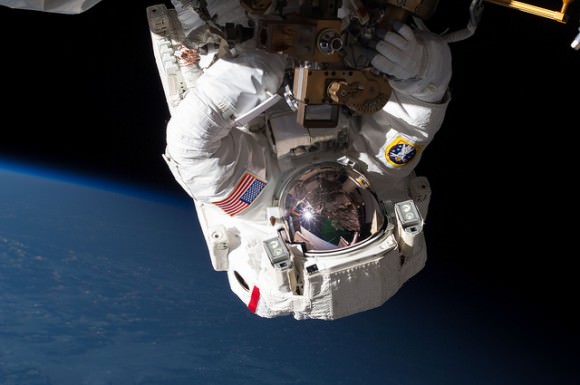
Also participating in the live NASA webcast are ‘Star Trek’ director J.J. Abrams, screenwriter and producer Damon Lindelof; and actors Alice Eve (Dr. Carol Marcus) and John Cho (Sulu) and astronauts Michael Fincke and Kjell Lindgren at NASA’s Johnson Space Center in Houston.
Fincke flew on the Space Shuttle and the ISS and made a guest appearance on the finale of the TV series – “Star Trek: Enterprise”. See photo below.
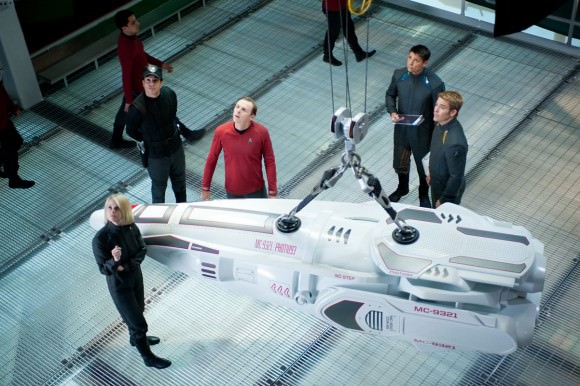
The ISS is a sort of early forerunner for the fictional ‘Federation’ in the ‘Star Trek’ Universe – constructed in low Earth orbit by the combined genius and talents of 5 space agencies and 16 nations of Earth to forge a united path forward for the peaceful exploration of Outer Space.
Cassidy will provide insights about everyday life aboard the real space station – like eating, sleeping, exercising and fun ( think Chris Hadfield’s guitar strumming ‘Space Oddity’ -watch the YouTube video below) – as well as the myriad of over 300 biological, chemical and astronomical science experiments performed by himself and the six person station crews during their six-month stints in zero gravity.
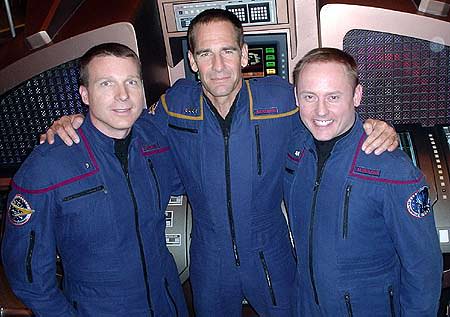
The participants will ask questions of each other and take questions from the Intrepid Sea, Air & Space Museum in New York City (home of the space shuttle Enterprise), the Smithsonian’s National Air and Space Museum in Washington, and social media followers, says NASA.
Social media followers were allowed to submit 30 sec video questions until early this morning.
And you can submit questions today and during the live broadcast using the hashtag #askNASA on YouTube, Google+, Twitter and Facebook.

Watch the hangout live on NASA’s Google+ page, the NASA Television YouTube channel, or NASA TV starting at Noon EDT, May 16.
As a long time Star Trek fan (since TOS) I can’t wait to see ‘Into Darkness’
…………….
Learn more about NASA missions, Mars, Curiosity and more at Ken’s upcoming lecture presentation:
June 12: “Send your Name to Mars” and “LADEE Lunar & Antares ISS Rocket Launches from Virginia”; Franklin Institute and Rittenhouse Astronomical Society, Philadelphia, PA, 8 PM.
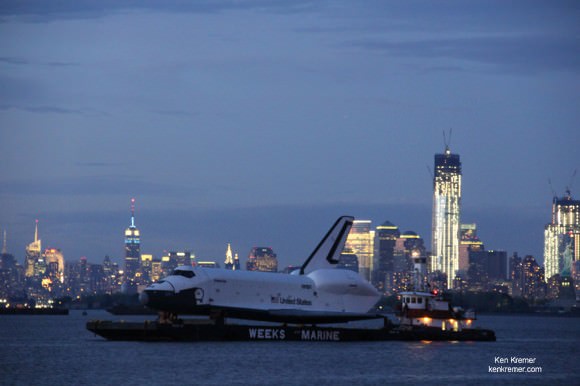
More Insight on How NASA Might Revive the Kepler Space Telescope
The future of NASA’s Kepler space telescope mission is in doubt, NASA announced yesterday, as it suffered a failure of a second reaction wheel, losing its ability to precisely point to look for planets orbiting other stars. Reaction wheels enable the spacecraft to aim in different directions without firing thrusters, and the spacecraft needs at least three of the four wheels working to provide the ability to point precisely enough to continue the mission.
But, as we pointed out in our article yesterday, the Kepler team said there are still possibilities of keeping the spacecraft in working order, or perhaps even finding other opportunities for different science for Kepler, something that doesn’t require such precise pointing abilities.
“We’re not ready to call the mission down and out just yet,” said John Grunsfeld, NASA’s associate administrator for the Science Mission Directorate, “but by any measure it’s been a spectacular mission.”
Space expert Scott Hubbard has provided additional insight on the possible ways that NASA could bring the spacecraft back online, and what planet hunters will do next if that’s not possible. Hubbard is a consulting professor of aeronautics and astronautics at Stanford’s School of Engineering, and served as director of NASA Ames Research Center during much of the building phase of the Kepler space telescope. He also worked on the project alongside William Borucki, the Kepler science principal investigator at Ames and the driving force behind the effort, for the decades leading up to formal approval of the mission.
Standford University provided this conversation Hubbard:
Q: How big of a loss will it be if the Kepler space telescope can’t be repaired?
Hubbard: The science returns of the Kepler mission have been staggering and have changed our view of the universe, in that we now think there are planets just about everywhere.
It will be very sad if it can’t go on any longer, but the taxpayers did get their money’s worth. Kepler has, so far, detected more than 2,700 candidate exoplanets orbiting distant stars, including many Earth-size planets that are within their star’s habitable zone, where water could exist in liquid form.
Kepler has done what the program managers said it would do, and that is to give us an inventory of extrasolar planets. It completed its primary observation phase, and had entered its extended science phase. We’re already in the gravy train period – there’s still a year and a half’s worth of data in the pipeline that scientists will analyze to identify other candidate planets, and there will continue to be Kepler science discoveries for quite some time.
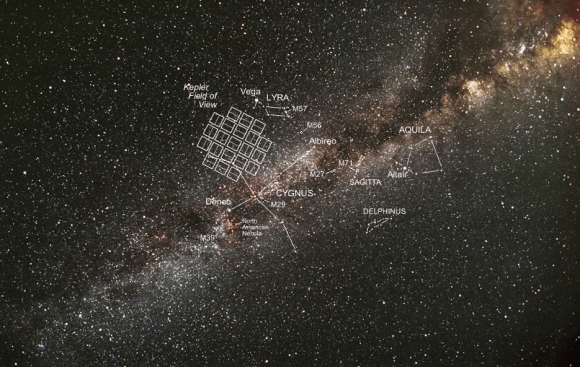
Q: How might NASA engineers go about getting Kepler functional again?
Hubbard: There are two possible ways to salvage the spacecraft that I’m aware of. One is that they could try turning back on the reaction wheel that they shut off a year ago. It was putting metal on metal, and the friction was interfering with its operation, so you could see if the lubricant that is in there, having sat quietly, has redistributed itself, and maybe it will work.
The other scheme, and this has never been tried, involves using thrusters and the solar pressure exerted on the solar panels to try and act as a third reaction wheel and provide additional pointing stability. I haven’t investigated it, but my impression is that it would require sending a lot more operational commands to the spacecraft.
Q: If neither of these options works, Kepler is still an amazing space instrument. Could it conduct other types of experiments?
Hubbard: People have asked about using it to find near-Earth objects, or asteroids. Kepler carries a photometer, not a camera, that looks at the brightness of stars, and so its optics deliberately defocus light from stars to create a nice spread of light on the detector, which is not ideal for spotting asteroids.
Whether or not it could function as a detector for asteroids is something that would have to be studied, but since it wasn’t built as a camera, I would say that I’m skeptical. That said, certainly between Ames Research Center and the Jet Propulsion Laboratory, they’ve got the best people in the world working on it.
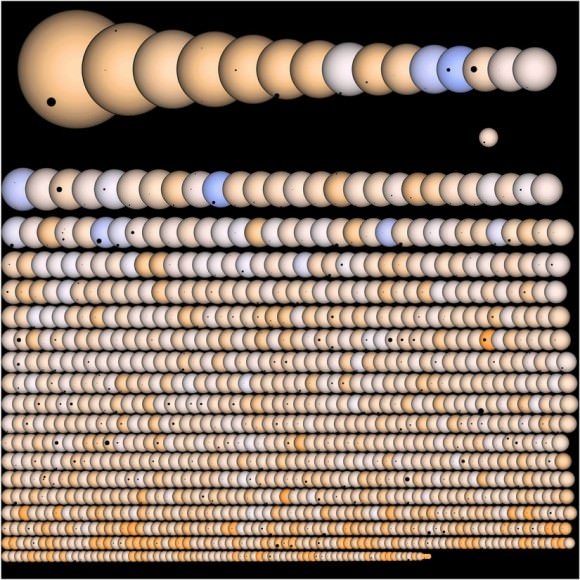
Q: What’s next for exoplanet hunters?
Hubbard: As I said earlier, there is still a year and a half’s worth of data in the pipeline to analyze to identify candidate planets, so there are still discoveries to be made.
It’s important to make clear, though, that in the original queue of missions aimed at finding life elsewhere, a mission like Kepler was a survey mission to establish the statistical frequency of whether these planets are rare or common. It lived the length of its prime mission, and was extremely successful during that time at achieving this goal. It has paved the way for additional missions, such as TESS – Transiting Exoplanet Survey Satellite – and TPF – Terrestrial Planet Finder – which will continue the search for Earth-like exoplanets in the near future.

